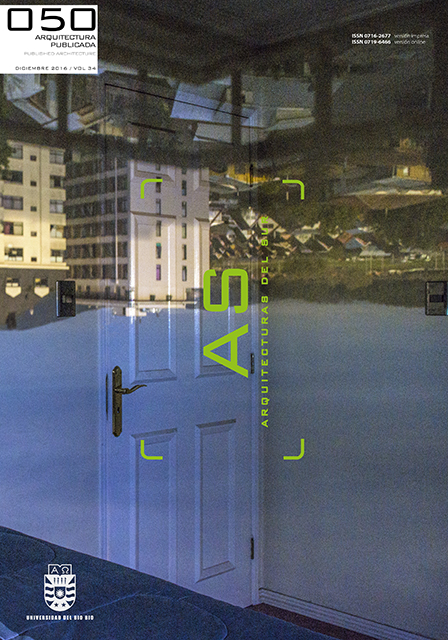From modern “style” to modern architecture: meanings of modern in the brazilian magazines a casa and arquitetura e urbanismo (1923- 1942)
DOI:
https://doi.org/10.22320/07196466.2016.34.050.02Keywords:
modern architecture, 20th century., history, historiography, magazines, 20th centuryAbstract
This article is based on research that analyzed a corpus of 225 issues of the magazines A Casa and Arquitetura e Urbanismo published between 1923 and 1942. It sought to identify transformations in meaning and forms of expressing that which is modern through the texts and images published. The objective was to understand how this term that encompasses a wide variety of expressions became a hegemonic tendency clearly defined in Brazilian architecture, which even accep- ted the name Modern Movement in order to be identified. The modern “style” appears in Brazilian magazines beginning with the 1925 International Exhibition of Modern Decorative and Industrial Arts in Paris, where different architectural displays were presented that were indistinctly identified as “modern” in the magazines analyzed. Ignored by most his- torical narratives, these varied expressions of modernity were responsible for conquering and fertilizing –largely due to the publication of specialized periodicals– a dry field in which would later flourish the exceptional and nationally and internationally celebrated works of modern Brazilian architecture with a Corbusian base.
Downloads
References
A machina de morar. A CASA, 1932, n° 97, pp. 8-10.
BRUAND, Yves. Arquitetura contemporânea no Brasil. São Paulo: Perspectiva, 1981.
BRUHNS, Ângelo. Architectura moderna. A CASA, 1931, n° 86, pp. 12-13.
COMAS, Carlos Eduardo. Moderna (1930 a 1960). En: Montezuma, Roberto (org.). Arquitetura Brasil 500 anos. Recife: UFPE, 2002.
COSTA, Lúcio. Muita construção, alguma arquitetura e um milagre. En: Correio da manhã, Caderno de Urbanis- mo e Construção, Rio de Janeiro, 15 jun. 1951.
COSTA, Lúcio. Arquitetura Brasileira. Rio de Janeiro: Ministério da Educação e Saúde/ Serviço de Documen- tação, série Os Cadernos de Cultura: 1952.
FICHER, Sylvia y ACAYBA, Marlene Milan. Arquitetura moderna brasileira. São Paulo: Projeto, 1982.
GOODWIN, Philip L. Brazil Builds: architecture new and old 1652 – 1942. Nova York: MOMA, 1943.
JORDÃO, Braz. O concreto armado como estylo architec- tonico. A CASA, 1926, n° 21, pp. 7-8.
JORDÃO, Braz. A arte moderna. A CASA, 1927, n° 39, pp. 13-16.
JORDÃO, Braz y AZEREDO, J. Cordeiro de. Editorial. A CASA, 1933, n° 106-107, p. 3.
LEMOS, Carlos A. C. Arquitetura brasileira. São Paulo: Melhoramentos, 1979.
MARTINS, Carlos Alberto Ferreira. A constituição da trama historiografia da arquitetura moderna brasileira. Revista da Pós – Número especial: o estudo da história na formação do arquiteto. São Paulo: FAU-USP, 1994.
MERLEAU-PONTY, Maurice. A Prosa do Mundo. São Pau- lo: Cosac & Naify, 2002.
MERLEAU-PONTY, Maurice. O Olho e o Espírito. São Pau- lo: Cosac & Naify, 2004.
MINDLIN, Henrique E. Arquitetura Moderna no Brasil. Rio de Janeiro: Aeroplano, 1999.
NERY, Juliana Cardoso. Falas e ecos na formação da arqui- tetura moderna no Brasil. Tesis doctoral inédita, PPGAU- UFBA, Universidade Federal da Bahia, 2013.
NIEMEYER, Oscar. Residência para o escritor Oswaldo de Andrade. ARQUITETURA E URBANISMO, 1939, n° 3, pp. 502-503.
Revistas de Arquitetura no Brasil. Revista Acrópole, 1963, edición conmemorativa, n° 295/296, pp. 201-203.
SEGAWA, Hugo. Arquiteturas no Brasil 1900-1990. São Paulo: EDUSP, 1997.
VEYNE, Paul Marie. Como se escreve a história. Brasília: UNB, 1995.
Downloads
Published
How to Cite
Issue
Section
License
Copyright (c) 2016 Juliana Cardoso Nery

This work is licensed under a Creative Commons Attribution-ShareAlike 4.0 International License.
The content of the articles published in each issue of Arquitecturas del Sur is the sole responsibility of the authors and does not necessarily represent the opinion of University of the Bío-Bío.
The authors will maintain their copyright; however, they will guarantee the journal the right to first publication and dissemination of their work. The publication of the article in Arquitecturas del Sur will be subject to the Creative Commons International license (CC BY-SA) that allows others to adapt: remix, transform and build on the material for any purpose, even commercially; share: copy and redistribute the material in any medium or format, as long as the authorship and first publication in this journal are acknowledged by citing them correctly, and their new contributions are under a license with the same terms.














 Programa de Información Científica/Concurso Fondos de Publicación de Revistas Científicas 2018/ Proyecto Mejoramiento de Visibilidad de Revistas UBB (Código:FP180007)
Programa de Información Científica/Concurso Fondos de Publicación de Revistas Científicas 2018/ Proyecto Mejoramiento de Visibilidad de Revistas UBB (Código:FP180007) 
